IDEX Online Company Profile: Tiffany & Co - Strong Financials & Superior Growth
May 01, 12
(IDEX Online) – If you are looking for the stellar performer among the publicly held jewelry retailers, look no further than Tiffany & Company.
Last year, the report card for Tiffany read like one you’d expect from your school valedictorian:
· Strong sales growth well above the industry average
· Top pretax profit margin among publicly held jewelers
· Accelerating new store growth
· Solid balance sheet and financials
· Celebrating 175 years, a record for an American-based public jewelry company
How Did They Do It?
Rather than being jealous, smart jewelers should study Tiffany. They would learn how the company posts consistently above-average financial returns and industry-leading growth. As they say, “retail is detail” and Tiffany management has mastered the details.
Tiffany is celebrating its 175th anniversary this year. While there may be other retailers who may have a longer history, this company’s history surpasses all other U.S. publicly held jewelers. They must be doing something right. What is it?
Here are a few key strategies, among many, that Tiffany implements:
· Tiffany has a detailed business plan, and management follows it – The company provides highlights of the plan in its legal filings. Unfortunately, we have not yet met an independent specialty jeweler who has a written business plan. If you don’t have a plan about where your business is going, how can you get there – wherever it is you are trying to go?
· Tiffany has an incredible brand – We continue to hammer the point: the store is the brand. Too many specialty independent jewelers try to use other brands to build their business. They rely on Rolex, Pandora and other brands. The only brand that builds is the supplier’s brand; it does nothing to build the jeweler’s brand.
· Tiffany has a reasonable average ticket – Tiffany’s average ticket, on a unit-weighted basis, is about $525 for its jewelry. That’s above the $300-400 average ticket of a mass-market specialty jeweler such as Kay and Zale, but it is well below the typical high-end jeweler’s average ticket of about $1,000. Tiffany jewelry represents accessible luxury.
· Tiffany keeps an eagle eye on expenses – The company’s high sales volume per store helps leverage operating costs. The company focuses on building sales per store, rather than simply adding stores to build sales.
· The company partners with a few key vendors – Those vendors are important to Tiffany, and Tiffany is important to those vendors. Far too many jewelers don’t try to partner with vendors; they don’t even understand the concept.
· Tiffany uses recessions for growth – Even during the Great Recession of 2007-2009, Tiffany opened stores, though at a slower-than-normal pace. However, its real estate specialists were cutting some great real estate deals for future stores.
Tiffany’s legal filings provide the most detailed view that is available for a publicly held entity. While there is much legalese in those hundreds of pages of filings, IDEX Online Research has sifted through the minutia and summarized nuggets that help explain “how Tiffany does it.”
Tiffany Financials Versus Industry Standards
It is helpful to compare Tiffany’s profit and loss statement as well as its balance sheet to the typical independent specialty retailer. While there may be some differences in how various costs are allocated, the bottom line is that Tiffany posted dramatically stronger financial results that most independent specialty retailers, as the table below illustrates:
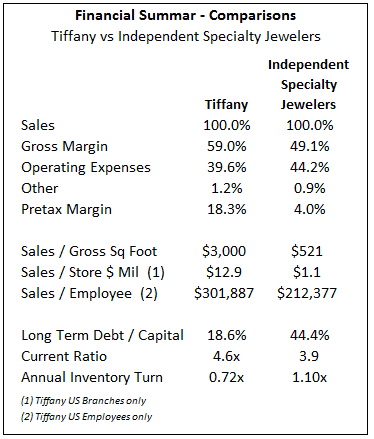 Source: Tiffany, Jewelers of America |
The only category where Tiffany lags the industry relates to its inventory turn. This is due to the company’s manufacturing operations: raw materials are brought in bulk and stored, prior to usage. If the inventory related to Tiffany’s manufacturing operations is removed, we estimate that the company’s retail inventory turn would be close to the industry average.
Tiffany defines its various expenses as follows:
· Cost of Sales (Cost of Goods Sold) – “Cost of sales” includes costs related to the purchase of merchandise from third parties, the cost to internally manufacture merchandise (metal, gemstones, labor, and overhead), inbound freight, purchasing and receiving, inspection, warehousing, internal transfers and other costs associated with distribution and merchandising. Cost of sales also includes royalty fees paid to outside designers and customer shipping and handling charges.
Most independent specialty jewelers include only merchandise costs and freight in their calculation of “cost of sales.” In short, Tiffany still posts a well-above average gross margin after including many more expenses than the typical independent specialty retailer. Tiffany regularly writes down its inventory for slow-moving and discontinued merchandise. Far too many independent specialty jewelers fail to write down the value of “dead” inventory.
· Selling, General & Administrative Expenses – These expenses include costs associated with the selling and marketing of products as well as administrative expenses. The types of expenses associated with these functions are store operating expenses (such as labor, rent, and utilities), advertising and other corporate level administrative expenses.
· Other Costs – Tiffany’s other expenses consist mostly of non-operating costs. It expenses store pre-opening and opening costs in the period incurred. Some independent specialty jewelers accrue those costs, and expense them over the life of the lease; this is misleading, in our opinion.
Tiffany Background
For the fiscal year of 2011 (ended January 2012), Tiffany’s sales were just over $3.6 billion, an 18% increase over the prior year. Based on preliminary global jewelry sales estimates of $150 billion for 2011, Tiffany has a global market share of almost 2.5%. Its $3.6 billion in sales makes it about the 130th largest “country” in the world, when comparing it to the Gross Domestic Product of the nearly 200 global countries.
Tiffany’s net earnings, even after unusual items, rose by 19% in 2011 – that’s greater than its sales growth, a goal every company should have.
Tiffany’s pretax margin of 18.3% was more than four times as high as the typical specialty jeweler in the American market whose pretax margin is 4.0%. Its return on stockholders’ equity was near 20%.
At the end of the year, the company operated 247 stores, a gain of 6% for the 12-month period.
Most Important Asset: Tiffany Brand
The first page of the company’s year-end legal filing has this quote: “The Tiffany & Co. brand is the single most important asset of Tiffany.” Far too many independent specialty jewelers miss this important concept: the store is the brand.
Tiffany’s legal filing is unusually candid about the trade-offs it makes to try to preserve its brand. For example, it says “Tiffany’s packaging supports consumer expectations with respect to the brand, but is expensive.” Far too many jewelers put a luxury product in a cheap box; not Tiffany.
Tiffany management goes on to admit: “Maintaining its position within the high-end of the jewelry market requires Tiffany to invest significantly in diamond and gemstone inventory and to accept reduced overall gross margins; it also causes some consumers to view Tiffany as beyond their price range.” Here’s what is important: Tiffany is saying that it can’t be all things to all people. Smart merchants understand that concept.
Tiffany’s Business
Tiffany has four key channels of distribution: 1) retail stores; 2) internet and catalog sales; 3) business-to-business sales; and 4) wholesale distribution of Tiffany branded merchandise to independent distributors for resale.
While the company does not break out sales by these segments, we have estimated sales by distribution channel, as follows:
· Retail & B-to-B – Roughly 94% of corporate sales
· Internet / Catalog – About 5-6% of total corporate sales
· Wholesale – Less than 1% of corporate sales
Tiffany does provide detailed sales and operating profits by geopolitical region, as follows:
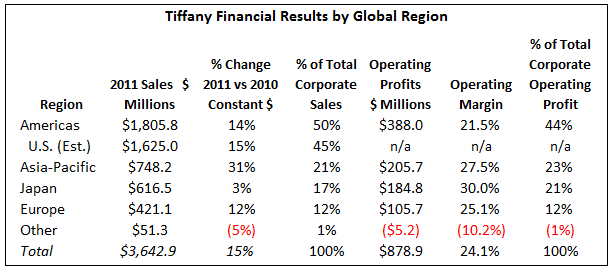 Source: Tiffany |
We note that this table does not include unallocated corporate expenses or certain other unallocated income or costs. The company’s overall operating margin, after taking into account these additional costs, was 19.4% in 2011, up from 19.3% in 2010 and 16.3% in 2009.
Strong Store Growth
In 2001, Tiffany operated 126 stores; a decade later – at the end of 2011 – it operated 246 units. It roughly doubled its store base over the past ten years, far surpassing any other public jeweler’s organic growth (non-acquisition growth).
Here’s a breakdown of its stores by major region in 2011 versus a decade ago in 2011.
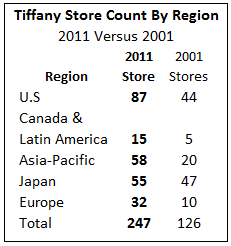 Source: Tiffany |
Within those regions, Tiffany provides significant operating data on its flagship stores and branch units, as the table below summarizes:
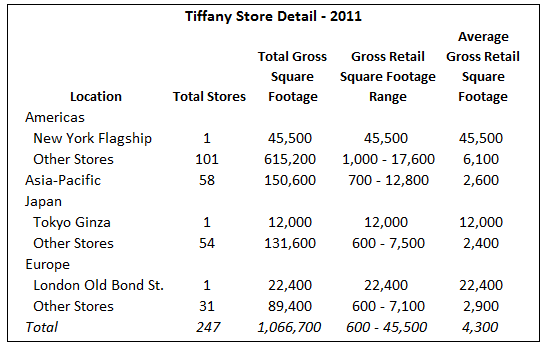 Source: Tiffany |
Sales per gross square foot generated by all Tiffany stores worldwide were about $3,000 in 2011, $2,600 in 2010 and $2,400 in 2009. The typical independent specialty retailer in the U.S. generates $521 sales per gross square foot of store space, and $728 per retail selling square foot, according to Jewelers of America. Upper-end AGS-type jewelers generate about $877 in sales per gross square foot of store space.
Sales By Product Segment
While Tiffany is known in America for its bridal jewelry, the sales mix of engagement jewelry and wedding bands is smaller in the U.S. than in any other of Tiffany’s regions.
The table below summarizes the company’s sales mix by geopolitical region.
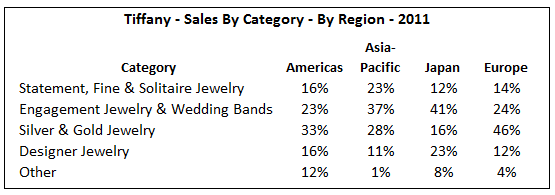 Source: Tiffany |
During the “Great Recession, Tiffany’s customers cut back on their purchase of expensive statement jewelry. However, beginning in 2010, the company’s mix of higher-priced jewelry has increased, as the table below illustrates:
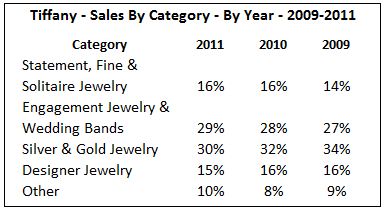 Source: Tiffany |
The importance of designer jewelry cannot be over-emphasized. This helps Tiffany differentiate itself from other merchants selling jewelry. For example, jewelry designed by Elsa Peretti accounted for 10% of global sales.
Tiffany provided the definitions of each of its product categories, as follows:
· Statement, Fine & Solitaire Jewelry – This category includes statement, fine and solitaire jewelry (other than engagement jewelry). Most jewelry in this category is constructed of platinum, although gold was used as the primary metal in approximately 5% of sales. Most items in this category contain diamonds, other gemstones or both. The average price of merchandise sold in 2011, 2010 and 2009 in this category was approximately $5,400, $4,400 and $4,200.
· Engagement Jewelry & Wedding Bands – This category includes diamond engagement rings and wedding bands marketed to brides and grooms. Most jewelry in this category is constructed of platinum, although gold was used as the primary metal in approximately 5% of sales. Most sales in this category are of items containing diamonds. The average price of merchandise sold in 2011, 2010 and 2009 in this category was approximately $3,800, $3,400 and $3,200.
· Silver & Gold Jewelry – This category generally consists of non-gemstone, sterling silver (approximately 70% of the category in 2011) or gold jewelry, although small gemstones are used as accents in some pieces. This category does not include jewelry that bears a designer’s name. The average price of merchandise sold in 2011, 2010 and 2009 in this category was approximately $250, $220 and $210.
· Designer Jewelry – This category generally consists of platinum, gold and sterling silver jewelry, some of which contains diamonds, other gemstones or a combination of both diamonds and other gemstones. This category includes only items that bear the name of and are attributed to one of the Company’s “named” designers: Elsa Peretti, Paloma Picasso, Frank Gehry and Jean Schlumberger. The average price of merchandise sold in 2011, 2010 and 2009 in this category was approximately $520, $450 and $420.
Advertising Levels Above Industry Average
Tiffany’s advertising-to-sales ratio is well above the industry average. In both 2010 and 2011, Tiffany spent about 6.4% of sales on advertising and marketing. This was up from 2009’s advertising and marketing expenditures of 5.9% of sales; this was at the end of the Great Recession when no amount of advertising could coax shoppers into stores.
The typical American specialty independent jeweler spends about 4.3% of sales on advertising and marketing, according to the Jewelers of America. Unfortunately, this level of spending is drowned by Tiffany, Kay, and others who spend substantially more on advertising and promotions.
Tiffany regularly advertises primarily in newspapers and magazines, and is increasingly using digital media. It also conducts product marketing events from time to time.
Tiffany Is Vertically Integrated
One of Tiffany’s competitive differentials is that it is vertically integrated: its produces a significant portion of its merchandise. In 2011, about 60% of Tiffany’s sales (by value) were derived from goods that it produces.
Tiffany produces jewelry and silver goods in New York, Rhode Island, and Kentucky; silver hollowware is produced in New Jersey. Other Tiffany subsidiaries process, cut, and polish diamonds outside of the U.S. The company leases facilities in Belgium, South Africa and Mauritius, and owns facilities in Botswana, Namibia and Vietnam to sort, cut and / or polish rough diamonds for use by Tiffany.
Management may increase its mix of internally produced goods, but says that it never expects to manufacture 100% of its product needs.
Tiffany’s & Diamonds – Five Key Vendors
The diamond mix for most independent specialty jewelers is about 45% of sales. For Tiffany, products containing one or more diamonds, either used as accents, side-stones, or center-stones, represented 55% of sales in 2011. Products containing one or more diamonds of one carat or larger accounted for 14% of sales in 2011, up from 12% in 2010 and 11% in 2009.
Tiffany purchases polished diamonds from five key vendors; a “significant” portion of those diamonds originate from DTC Sightholders.
In recent years, about 50% to 60% of the polished diamonds acquired by Tiffany for use in jewelry have been produced from rough diamonds purchased by the company and then polished in company facilities or third parties.
Tiffany’s goal is to purchase as many rough stones as possible to support its diamond needs. Tiffany has agreements with various diamond producers to purchase defined portions of their mines’ output. Under those agreements, Tiffany expects to purchase about $200 million of rough diamonds in 2012. The company has also provided loans to certain of its diamond suppliers, and it has been a party (guarantor) to miners’ credit facilities in the past.
Tiffany’s Finished Fine Jewelry – 70 Vendors
Tiffany purchases finished jewelry from about 70 manufacturers, most of whom have long-standing relationships with the company.
Tiffany’s watch production has encountered some glitches recently. Prior to 2007, the company acquired Tiffany & Co. branded watches from various Swiss manufacturers. In 2007, the company entered into a 20-year license and distribution agreement with the Swatch Group. For a variety of reasons, relations between Tiffany and Swatch deteriorated, and both want out of the deal.
We think it has to do with low sales volumes. Watch sales at Tiffany stores were about 1% of global net sales in 2011, flat with 2010 and 2009. Royalty revenues from the agreement with Swatch were less than 1% of revenues in 2011 and 2010.
Tiffany’s Key Strategies
Tiffany management outlined its key strategies, as follows:
· To selectively expand its global distribution without compromising the value of the Tiffany brand – Management employs a multi-channel distribution strategy, and intends to expand distribution by adding stores in both new and existing markets, as well as by launching e-commerce websites in new markets. Management recognizes that over-saturation of any market could diminish the distinctive appeal of the brand, but believes that there are a significant number of potential worldwide locations remaining that meet the requirements of the Tiffany brand.
· To enhance customer awareness – The Tiffany brand is the single most important asset of the Company. Management will continue to invest in marketing and public relations programs designed to increase new and existing customer awareness of the brand and its message.
· To increase store productivity – Tiffany is committed to growing sales per square foot by increasing consumer traffic and raising the “conversion rate” (increasing the percentage of store visitors who make a purchase) through advertising, ongoing sales training and customer-focused initiatives. In addition, in recent years, the company has opened smaller size stores in the U.S. which have contributed to higher store productivity.
· To achieve improved operating margins – Management’s long-term objective is to improve its operating margin through greater efficiencies in product sourcing, manufacturing and distribution as well as by controlling selling, general and administrative expenses and enhancing productivity so that sales growth can generate a higher rate of earnings growth.
· To maintain an active product development program – The company will continue to invest in product development in order to introduce new design collections and expand existing lines.
· To maintain substantial control over product supply through direct diamond sourcing and internal jewelry manufacturing – The company’s diamond processing operations purchase, sort, cut and/or polish rough diamonds for use in company merchandise. Tiffany will continue to seek additional sources of diamonds which, combined with its internal manufacturing operations, are intended to secure adequate product supplies and favorable costs.
· To provide superior customer service – Maintaining the strength of the Tiffany brand requires that the company make superior customer service a top priority.
Tiffany’s Sales Slightly Less Seasonal
In the U.S. market, the fourth calendar quarter is the all-important period for jewelers: this is the Christmas / holiday period.
Because half of Tiffany’s sales are derived from overseas stores in many countries that do not celebrate Christmas – or do not make it a commercial event as has occurred in America – its quarterly corporate sales tend to be slightly less seasonal than the U.S. jewelry industry. Even Tiffany’s sales in the Americas, where all countries celebrate Christmas, are less seasonal than the U.S. jewelry industry, as the table below illustrates:
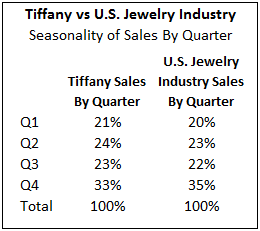 Source: Tiffany, US Dept of Comm |
Tiffany Outlook Calls For Solid Growth in 2012
Management’s outlook is based on the following assumptions, which may or may not prove valid:
· A worldwide net sales increase of approximately 10% for the full year – This will primarily be driven by sales growth in Asia-Pacific and the Americas.
· The opening of 24 (net) company-operated stores (nine in the Americas, seven in Asia-Pacific, three in Europe and commencing operation of five stores in emerging markets) – New store openings are ramping up in 2012.
· Operating margin approximately equal to 2011 (when excluding nonrecurring items recorded in 2011), with an improved ratio of SG&A expenses to net sales offset by a decline in gross margin – While the projected decline in gross margin is disappointing, the company has a history of under-promising and over-delivering.
· Interest and other expenses, net approximately equal to 2011 – Management will cap the growth of other expenses.
· An effective income tax rate of approximately 34% – 35% – This is in line with the typical corporate tax rate in the U.S.
· Net earnings per diluted share growth of 16% to19% increase over 2011, with most of the year-over-year growth occurring in the latter part of the year.
· An increase in net inventories of approximately 15% – This is greater than the company’s planned sales growth, and it reflects a continuing stream of new products to entice customers into its stores.
Capital expenditures of approximately $240,000,000 – That’s one-quarter of a billion dollars that the company plans to spend on capital projects.